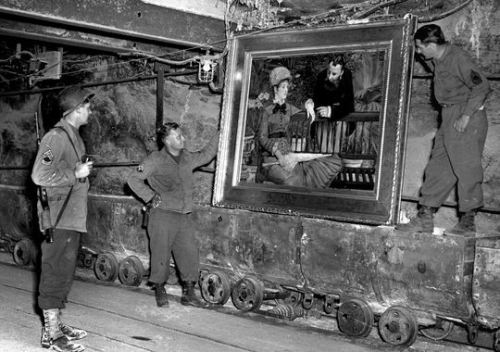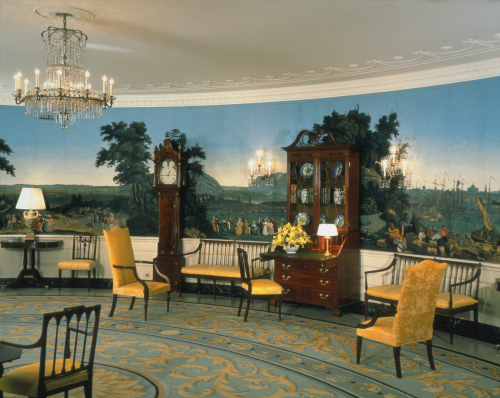James Rada Jr.'s Blog, page 29
November 7, 2013
$1.35 Billion in art work stolen by the Nazis recovered

American soldiers recover some of the art work stolen by the Nazis during WWII.
I just saw an episode of “Bones” where an old Nazi was murdered in South America and in his basement they found art work, gold, pictures and other items he had been hiding. Then a real-life story of Nazi theft caught my attention.
Just recently more than 1,500 paintings that haven’t been seen in 75 years were recovered. Many of them had been believed destroyed during the war.
Three years ago customs officials doing a routine check on a train from Switzerland met an man from Munich, Germany, named Hildebrant Gurlitt. It turns out the Gurlitt was a fake name.
Officials tracked him down in 2011 to an small apartment.
“Behind “mountains of rotting food and decades-old tin cans” lay a collection of artworks thought to be worth over $1.35 billion, including paintings by Picasso, Matisse, and Renoir,” reported TheVerge.com.
Many of the pieces came from Gurlitt’s father who was an art historian. Cornelius Gurlitt acquired many of the paintings from Jews who were trying to raise capital to get out of Germany after the rise of the Third Reich. Cornelius took advantage of the Jews’ desperation and bought them for next to nothing. Other pieces had been seized outright by the Nazis.
“A total of 121 framed and 1,285 unframed works, among them works by famous artists, were seized,” prosecutor Reinhard Nemetz told CNN.com. “There were oil paintings, works in india ink, pencil, watercolors, lithographs and prints.”
Gurlitt had been making a living selling off some of the lesser-known pieces in order not to draw attention to himself. Though he wasn’t living a flashy lifestyle, investigators found one bank account with $650,000 in it.
Officials are now searching for the original owners of the art work. “It’s believed that one of the Matisse paintings may belong to Anne Sinclair, the wife of disgraced politician Dominique Strauss-Kahn, the former head of the International Monetary Fund facing trial in France for his part in abetting a sex trafficking ring,” TheVerge.com.
Here’s the link to The Verge and CNN.


October 30, 2013
White House wallpaper came from house waiting to be demolished
 The White House staff darted back and forth even busier than usual on September 20, 1961. A State dinner was to be held for Peruvian President Manuel Prado, but the Diplomatic Reception Room, the first room that President Prado and the other guests would see was filled with workmen, paint cans and drop cloths.
The White House staff darted back and forth even busier than usual on September 20, 1961. A State dinner was to be held for Peruvian President Manuel Prado, but the Diplomatic Reception Room, the first room that President Prado and the other guests would see was filled with workmen, paint cans and drop cloths.
The staff was used to preparing dinners and receptions for President John F. Kennedy and his wife, but they weren’t used to having to make the preparations while weaving in between workmen who were redecorating one of the rooms they needed to prepare.
Peter Guertler of New York was in charge of redecorating the Diplomatic Reception Room with antique wallpaper acquired from the Stoner House in Thurmont.
“We just sneaked out as the guests arrived,” Guertler told the Associated Press at the time.
“Sitting on empty champagne cases, they were busy until the last minute carefully putting the scenic panels into place on the circular walls of the diplomatic reception room,” AP reported.
It was the completion of a three-week project by three artists. They had remounted the 1834 wallpaper and restored the frayed edges and holes.
Upon entering the White House through the Diplomatic Reception Room, the first thing the 90 guests at the State dinner saw was the antique wallpaper from Thurmont showing them an America that never quite was.
Saved from destruction
The historic wallpaper had been saved from destruction only a few months earlier and quickly found its way into the most-prestigious home in the America.
Peter Hill, a Washington DC resident, sold antiques and used the profits to spread the gospel as a lay preacher. In May, he needed cash to continue his missionary work. At that point, “as if by divine guidance,” he said in a Washington Post article, friends told him of an antique auction at the Stoner House in Thurmont, Maryland, a small town in central Maryland.
The stone house on East Main Street was built in 1838 by William Jones who owned a tannery along Hunting Creek. Eugenie and Daniel Rouzer purchased the home in 1891. The Rouzers’ daughter Gertrude and her husband, William Stoner, eventually inherited the house.
Gertrude Stoner sold the house in 1961 and it was scheduled for demolition to make room for a grocery store.
On Saturday, April 1, as Hill entered the house to view the furnishings that were to be auctioned off, he spied the wallpaper in the front hallway. The panoramic scenes showed a general view of New York City and its bay seen from atop Weehawken, the fortifications and parade ground at West Point, Niagara Falls covered in mist, Natural Bridge in Virginia and a view of Boston and its harbor. The set of wallpaper panels was called “Scenic America” and created in 1834. It had hung in the Stoner House since nearly that time.
“To American historians, the scenes of the U.S.A. may look strange,” Dorothy McCardle wrote in the Washington Post. “It is not pictorial American history as an Early American would have illustrated it. “
Dora Brahm, a member of the National Society of Interior Decorators, said at the time that the natural elements and buildings looked natural. It was the people in the pictures that gave the wallpaper its unusual appearance because they looked more Parisian than American.
Hill told Stoner he wanted to purchase the wallpaper, but she told him he would have to negotiate with Ralph Miller who was in charge of the demolition that was scheduled to start in two days.
Miller told Hill that a woman had offered $100 for the wallpaper, but would not be able to remove it before the house was demolished, according to a 1961 Frederick Post article.
“Hill invested his savings in buying the wallpaper on the spot,” McCardle wrote. “There was only one proviso. He would have to have it off the walls before the house was torn down at the end of next week.”
Hill paid $50 and spent three days removing the complete set of “Scenic America” wallpaper with a razor blade and putty knife.
“Knowing the value of his find, Hill also took time to measure the hall, and to take samples of woodwork in case a museum should want to reconstruct the entire hall,” reported The Frederick Post.
From France by way of Thurmont
William Jones was a prosperous tannery operator in Thurmont in the 1800’s. To show his prosperity, he built a six-room stone house on Main Street. That was not enough, though. To give his new home a touch of elegance and class, he ordered new panoramic wallpaper from the French company of Jean Zuber.
Gertrude Stoner had written to Gregory and Brown Co., an interior decorating firm, in 1929 trying to find out the history of the unusual wallpaper. J.C. Waterman replied saying the print was called “Scenic America” and manufactured by a French manufacturer J. Zuber in Rixheim, Alsace. The scenes were taken from a set of Currier and Ives prints.
In 1834 when the wallpaper was manufactured, it would have taken about a year to produce a complete set, which consisted of 32 strips. Each strip was 18.5 inches wide and 11.5 feet long.
Producing a new design of wallpaper was a major investment for the company. Besides research and design time, production time was extensive. It could take the efforts of up to 50 men applying 223 colors to 1,674 wood blocks to produce the wallpaper. The wood blocks were carved to leave various portions of the print raised. The paint was applied to the raised portions and then pressed against the fine linen rag paper. Design runs for each design was limited to about 50 sets.
“It was reported that Zuber’s wallpapers were so renowned that King Louis Philippe honored him with the Legion of Honor in 1834, the year that ‘Scenic America’ was printed,” reported The Frederick Post.
The wallpaper was an extravagant cost at the time of $10.
It journeyed from France to Thurmont in tin foil tubes of protect it from the moisture of an ocean crossing.
On to the White House
On Thursday, April 6, Hill notified the Smithsonian Institution of his find. He knew John Newton Pearce of the Cultural Historical Section through some previous antique sales he had made to the Smithsonian. The following day, Hill took the wallpaper to the White House and spread it out on the floor of Pearce’s wife’s office. Mildred Pearce was the White House curator.
First Lady Jacqueline Kennedy walked into the office around noon with two of her friends. “The historic paper, displaying the French flavor she likes so well, caught the first lady’s eye instantly,” wrote McCardle. Kennedy decided on the spot that she wanted the wallpaper.
The Diplomatic Reception Room was chosen as the room where the wallpaper would be hung, in part, because the National Society of Interior Designers was redesigning the room with an Americana theme. The round walls of the room also worked well to display the panoramic wallpaper. The First Lady asked the society to purchase the wallpaper for the room as part of what would be an $180,000 redecoration of the room.
However, the wallpaper from the Stoner House was not enough to finish the entire room. Mrs. Pearce was able to find an additional 25 feet in a New York antique shop to finish the project.
The original design was also too short for the space that needed to be filled, but Guertler came up with a solution. Where the paper was too short to fully reach the ceiling of the diplomatic reception room, he carefully painted in inches of blue sky, matching the color of the wallpaper.
The society purchased the wallpaper for $17,500, though it paid only $12,500 for it, which was the amount they could afford according to McCardle. In a letter dated Aug. 14, 1961, Hill told Stoner that the difference was “given in the name of Thurmont.”
Though not known at the time of purchase, the White House could have purchased a modern set of the wallpaper, produced by Jean Zuber and Co. The company has been in France since 1797 and is still in business (www.zuber.fr). The company’s web site claims it is the last factory in the world still producing wallpaper using wood blocks. It also still uses the original wood blocks. A new set of the wallpaper in 1961 would have cost around $2,200 and not needed repairs.
To view more of the historic Thurmont wallpaper in the White House, visit the White House Historical Association at www.whha.gov.


October 24, 2013
Thurmont’s “Cat Lady” lived in an old bus
Mae Carbaugh lived the quiet life of a hermit. She rarely left her home along Route 81 close to the Western Maryland Railway tracks near Thurmont. Yet, in the months before she died in 1974, her life was national news.
Carbaugh wasn’t a native of Frederick County. She was born on a farm in Delaware in 1896. Deciding that the farming life wasn’t for her, Carbaugh left home at age 16. She wound up working as a hotel restaurant waitress in Emmitsburg until the hotel closed.
She married Charles Carbaugh and the couple had a daughter. Charles was an alcoholic and didn’t work much so when he died in 1953, he left his wife with nothing. Mae found work as a housekeeper for an elderly bachelor, though.
“When the old bachelor died, she continued, she had no place to live. So she bought a bus for $100 15 years ago, parked it on public land and has lived there ever since,” the Baltimore Sun wrote about her in 1970.
“I’ve been wanting a house all these years. But the houses in Thurmont rent for about $50 a month and I don’t have that kind of money,” she told the Frederick Post.
While the old bus was Carbaugh’s home, many people considered it an eyesore. Some of them tried to get her evicted, but Frederick Wilhide, the property owner, told them that as long as Carbaugh wasn’t causing any problems, she could stay.
Although Carbaugh didn’t cause problems, she was the focus of some problems. Vandals had caused a lot of damage to the bus over time. The windows were covered with wood or sheet metal because rocks had broken the windows.
“Although most townspeople don’t associate with the old woman, neighborhood kids do pay visits. They start small fires near her camp site, toss rocks at her gray and blue bus and sneak up in the dead of night and hoot and howl like enraged witches.
“’On Halloween night it’s really bad,’ she says, her voice quivering, ‘All these kids come up and throw rocks at me and my cats. I don’t know why they want to hurt us,’” the Hagerstown Mail reported.
To make her bus livable, Carbaugh added a small wood stove inside with a stove pipe that could be seen protruding from the roof of the bus.
“It’s a hard time firing the stove for 24 hours to keep from freezing,” Carbaugh said.
There was also a bed and piles upon piles of used clothing that sometimes grew moldy.
However, the bus had no indoor plumbing. “She kept a pot inside and when it got full, she buried its contents in the woods, using a shovel she kept there for that purpose,” the Baltimore Sun reported.
The Sun reporter who met with the 74-year-old Carbaugh described her as having a wrinkled face “almost obscured by a knit cap pulled down on a swarthy forehead.” When the reporter from the Mail interviewed her, he noted that she wore a torn red dress and one black shoe and one brown one.
She got by picking up soda bottles off the side of the road and taking them into a nearby gas station for the deposit. People passing by in cars would also stop and give her food and clothing.
Her daughter, Mary, had lived away from her parents from the age of five and never visited her mother in Thurmont.
She said of her mother in the Frederick Post, “Some people don’t like to be around lots of people. Everybody has their own individual mind. I couldn’t live that way. I like to be around people. I don’t like to be alone. There are lots of possibilities why she was the way she was. She wasn’t crazy. She was peculiar. She lost both her parents when she was 16, you know. We don’t know what that may have done to her.”
Following the publication of the Baltimore Sun story in 1970, a Baltimore businessman gave Carbaugh a green trailer.
“The businessman suggested she move into a modern trailer camp but Mrs. Carbaugh would have none of it. She refused to move from the spot near the stream where she gets her drinking water in a bucket. And she refused to take the hint that she change her ways,” the Hagerstown Mail reported.
Around Thurmont, Carbaugh was known as “The Cat Lady” because she kept two or three cats as pets.
When Carbaugh died on October 23, 1974, the Frederick Post called her trailer a landmark. After all, it had been in the same location for 20 years.
It was a landmark that quickly disappeared, though. “The piles of wood and debris were gone, the worn trailer was empty, locked and lonely, the green wooden doghouse overturned and deserted. On the leaf-covered ground, some spilled navy beans, tired scraps of foil and bits of cloth — materials for next spring’s birds nests — were all that told of a once strange and independent existence,” the newspaper reported shortly after her death.
The Baltimore Sun said of her, “To some she was the last of a hardy breed . . .an eccentric who lived her own life as she saw fit, who wanted to be alone and to be left alone.”
Her funeral services were held at the Creager Funeral Home and Carbaugh was interred at Blue Ridge Cemetery on October 26, 1974.


October 7, 2013
REVIEW: Lost in Shangri-La by Mitchell Zuckoff
I admit that Lost in Shangri-La caught by attention because of Shangri-La in the title. That is what Camp David used to be called and I live near there. However, once I read that cover copy that it was a survival story and rescue mission I was intrigued.
Near the end of WWII, a plane took off from a U.S. Army camp in New Guinea. It carried two dozen people and was supposed to be flying on sightseeing trip and giving the soldiers and WACs aboard a little rest and relaxation. That was until the plane crashed in the jungle high in the mountains.
Five people survived initially, though two of them died within a day. The remaining three survivors had various injuries, but they managed a three-day hike with nothing to eat but Charms candy. (This fact probably sticks with me the most from the book.)
Some of the tribes in the jungle were known to be cannibalistic, but the survivors were lucky enough to meet a tribe that had never seen white people but they were friendly. The two groups couldn’t communicate, but were friendly and got along.
A rescue plane found the survivors after a few days. It couldn’t land, but it was able to help two medics parachute into the area. The medics hiked to the survivors and began giving them needed medical attention. A few days later another group of paratroopers landed in the area to offer help and protection if necessary.
With troops now on the ground, the trick was to find a way to get them back to the camp. Planes couldn’t land, helicopters couldn’t operate at that altitude and it was a 150-mile hazardous march with wounded personnel back to camp. Their solution was a daring rescue that mission that I won’t spoil.
I enjoyed the book. It was well written and it told an interesting story as a story. Though it went off on tangents to tell the background of the characters in the story, they weren’t overly long or uninteresting so I didn’t mind them at all.
I would definely recommend this.


September 30, 2013
Death in a bottle: the mysterious unsolved Tylenol murders.
 Reblogged from www.seanmunger.com:
Reblogged from www.seanmunger.com:


Thirty-one years ago today, on September 29, 1982, a 12-year-old girl named Mary Kellerman, who lived in Elk Grove Village, Illinois, died after taking a single capsule of the popular pain reliever drug Tylenol. Within a few days, six more people in the Chicago area were dead, including Stanley and Teresa Janus of Lisle, Illinois--Stanley's brother Adam was also among the dead--who had swallowed Tylenol capsules from the same bottle.
I remember when this happened. I didn't know that the murderer had never been caught, though. My excuse is that I was in middle school so I'm lucky that I paid attention to anything. However, didn't this case lead to a new way of packaging so that it was easier to see if medicines had been tampered with?
September 19, 2013
Working on my blog design
So what do you think about the additions to my blog? I’ve been working on some new pages and tweaking the elements on the sidebar.
I added a book catalog page where you can order my books without having to go to my web site or an online retailer. I also added a “Hire Me” page to promote myself and my writing credentials.
On the sidebar, I added things like an “About Me” widget, a cover gallery and a Twitter feed.
I figure it will be an intermediate step in my blog design. My next step will probably be jazzing up the title font and backgrounds. I wanted to see how these additions work out first.
So how is it looking to you so far?





